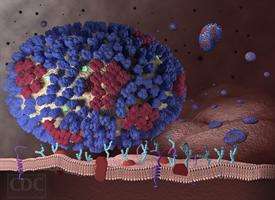Researchers discover rare flu-thwarting mutation

A rare and improbable mutation in a protein encoded by an influenza virus renders the virus defenseless against the body's immune system. This University of Rochester Medical Center discovery could provide a new strategy for live influenza vaccines in the future.
A new approach to the live flu vaccine would be particularly advantageous right now after the Centers for Disease Control and Prevention stopped recommending use of the live attenuate flu vaccine, FluMist earlier this year. Several studies found that the pain-free nasal spray, which was used in about one-third of young children in the U.S., offered no protection to that especially vulnerable population. The flu shot, on the other hand, performed well and the CDC recommends using this vaccine in place of FluMist.
"There is a need to understand what's happening with the existing live vaccine and potentially a need to develop a new one," said David Topham, Ph.D., Marie Curran Wilson and Joseph Chamberlain Wilson Professor of Microbiology and Immunology at URMC and author of the study. "We proposed that the mutation we found could be used to create a live vaccine."
The mutation weakens the flu virus by making the flu-encoded protein, called Non-Structural 1 (NS1), defunct. Flu virus needs NS1 to prevent interferon, the immune system's front line against viruses, from alerting the host cell that it has been infected. Inhibiting interferon affords the virus time to multiply and spread before the immune system can mount an attack.
Most people have healthy interferon responses and would quickly and easily fend off this weakened mutant strain of flu, but, "this virus somehow managed to find the one person that had an interferon defect that allowed it to replicate," said Topham.
The probability of this virus surviving and infecting a human is so low - it is as if Topham and lead study author, Marta Lopez de Diego, Ph.D., research assistant professor of Microbiology and Immunology, found a needle in a haystack. The pair isolated the mutated virus from a nasal swab of a single flu sufferer who happened to be among the small percentage of people with inadequate interferon responses. When they looked for the NS1 mutation in a national database, it showed up in just 0.03 percent of all flu strains reported.
This naturally-occurring "attenuating" flu mutation could provide a new way to make live flu vaccines, which contain viruses that are alive, but "attenuated", or weakened, so the vaccine itself does not cause illness in humans. Topham and Lopez de Diego suspect their NS1 mutation could be a great way to prevent viruses in the live vaccine from infecting anyone who has normal interferon responses, which is most people.
The study, published online in the Journal of Virology, also highlights the importance of flu virus surveillance – conducting studies like Topham's to see how the flu is changing, what flu mutations are circulating in humans and animals, and how those mutations affect virus function.
Topham believes health leaders are not doing enough of that research. "The influenza field is largely fixated on studying pandemic or potential pandemic viruses, but those viruses only infect a few dozen people every year whereas seasonal flu infects millions - and yet we don't study human influenzas closely enough."
In fact, the World Health Organization estimates 1 billion flu infections each year, causing 300,000 to 500,000 deaths.
Until recently, researchers believed that proteins like NS1 did not change much from strain to strain and season to season, but Topham's study and others show that NS1 mutations occur naturally and can affect its ability to suppress immunity. Monitoring for these mutations in nature could help us produce better vaccines that save more lives.
More information: Marta L. DeDiego et al. An NS1 protein mutation (I64T) affects interferon responses and virulence of circulating H3N2 human influenza A viruses, Journal of Virology (2016). DOI: 10.1128/JVI.01039-16


















